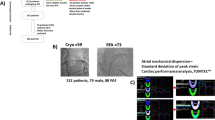Abstract
Background
Advancing age is a strong risk factor for the development of atrial fibrillation (AF). However, its impact on the left atrial (LA) substrate in patients is not well defined.
Methods
Forty-seven patients underwent catheter ablation of persistent AF. Bipolar electrograms from the LA were recorded for voltage analysis. The AF cycle length was determined by averaging the cycle lengths of ten fibrillatory (“f”) waves on lead V1. The mean amplitude of the same ten “f” waves was also determined. The ablation strategy consisted of pulmonary vein isolation, electrogram guided, and linear ablation.
Results
There was an inverse relationship between the mean bipolar LA voltage and age (R = −0.58; P < 0.0001). There was a direct relationship between AF cycle length and age (R = 0.74; P < 0.0001). There was an inverse relationship between amplitude of the “f” waves and age (R = −0.62; P < 0.0001). Areas of scar were found in 15 of the 47 patients (32%). AF cycle length was longer in patients with vs. those without scar (183 ± 20 vs. 151 ± 15 ms; P < 0.0001). Advancing age was the only predictor of LA scar (OR, 1.32; 95% CI, 1.11–1.58; P < 0.01). Forty patients (85%) remain arrhythmia-free without antiarrhythmic medications after a mean follow-up of 18 ± 10 months. Neither age nor LA scar was associated with outcome.
Conclusions
In patients undergoing ablation of persistent AF, advancing age makes for a complex LA substrate that is characterized by areas of low voltage/scar, and yet is associated with a lower AF frequency. LA scar did not seem to impact outcome in this small study.







Similar content being viewed by others
References
Go, A. S., Hylek, E. M., Phillips, K. A., Chang, Y., Henault, L. E., Selby, J. V., & Singer, D. E. (2001). Prevalence of diagnosed atrial fibrillation in adults: national implications for rhythm management and stroke prevention: the Anticoagulation and Risk Factors in Atrial Fibrillation (ATRIA) Study. Journal of the American Medical Association, 285, 2370–2375.
Kistler, P. M., Sanders, P., Fynn, S. P., Stevenson, I. H., Spence, S. J., Vohra, J. K., Sparks, P. B., et al. (2004). Electrophysiologic and electroanatomic changes in the human atrium associated with age. Journal of the American College of Cardiology, 44, 109–116.
Roberts-Thomson, K. C., Kistler, P. M., Sanders, P., Morton, J. B., Haqqani, H. M., Stevenson, I., Vohra, J. K., et al. (2009). Fractionated atrial electrograms during sinus rhythm: relationship to age, voltage, and conduction velocity. Heart Rhythm, 6, 587–591.
Matsuo, S., Lellouche, N., Wright, M., Bevilacqua, M., Knecht, S., Nault, I., Lim, K. T., et al. (2009). Clinical predictors of termination and clinical outcome of catheter ablation for persistent atrial fibrillation. Journal of the American College of Cardiology, 54, 788–795.
Nault, I., Lellouche, N., Matsuo, S., Knecht, S., Wright, M., Lim, K. T., Sacher, F., et al. (2009). Clinical value of fibrillatory wave amplitude on surface ECG in patients with persistent atrial fibrillation. Journal of Interventional Cardiac Electrophysiology, 26, 11–19.
Platonov, P. G., Nault, I., Holmqvist, F., Stridh, M., Hocini, M., & Haissaguerre, M. (2011). Left atrial appendage activity translation in the standard 12-lead ECG. Journal of Cardiovascular Electrophysiology, 22, 706–710.
Swartz, M. F., Fink, G. W., Lutz, C. J., Taffet, S. M., Berenfeld, O., Vikstrom, K. L., Kasprowicz, K., et al. (2009). Left versus right atrial difference in dominant frequency, K(+) channel transcripts, and fibrosis in patients developing atrial fibrillation after cardiac surgery. Heart Rhythm, 6, 1415–1422.
Yoshida, K., Rabbani, A. B., Oral, H., Bach, D., Morady, F., Chugh, A., et al. (2011). Left atrial volume and dominant frequency of atrial fibrillation in patients undergoing catheter ablation of persistent atrial fibrillation. Journal of Interventional Cardiac Electrophysiology, 32, 155–161.
Stiles, M. K., John, B., Wong, C. X., Kuklik, P., Brooks, A. G., Lau, D. H., Dimitri, H., et al. (2009). Paroxysmal lone atrial fibrillation is associated with an abnormal atrial substrate: Characterizing the “second factor”. Journal of the American College of Cardiology, 53, 1182–1191.
Verma, A., Wazni, O. M., Marrouche, N. F., Martin, D. O., Kilicaslan, F., Minor, S., Schweikert, R. A., et al. (2005). Pre-existent left atrial scarring in patients undergoing pulmonary vein antrum isolation: an independent predictor of procedural failure. Journal of the American College of Cardiology, 45, 285–292.
Oakes, R. S., Badger, T. J., Kholmovski, E. G., Akoum, N., Burgon, N. S., Fish, E. N., Blauer, J. J., et al. (2009). Detection and quantification of left atrial structural remodeling with delayed-enhancement magnetic resonance imaging in patients with atrial fibrillation. Circulation, 119, 1758–1767.
Tuan, T. C., Chang, S. L., Tsao, H. M., Tai, C. T., Lin, Y. J., Hu, Y. F., Lo, L. W., et al. (2010). The impact of age on the electroanatomical characteristics and outcome of catheter ablation in patients with atrial fibrillation. Journal of Cardiovascular Electrophysiology, 21, 966–972.
Corrado, A., Patel, D., Riedlbauchova, L., Fahmy, T. S., Themistoclakis, S., Bonso, A., Rossillo, A., et al. (2008). Efficacy, safety, and outcome of atrial fibrillation ablation in septuagenarians. Journal of Cardiovascular Electrophysiology, 19, 807–811.
Zado, E., Callans, D. J., Riley, M., Hutchinson, M., Garcia, F., Bala, R., Lin, D., et al. (2008). Long-term clinical efficacy and risk of catheter ablation for atrial fibrillation in the elderly. Journal of Cardiovascular Electrophysiology, 19, 621–626.
Fiala, M., Wichterle, D., Chovancik, J., Bulkova, V., Wojnarova, D., Nevralova, R., & Januska, J. (2010). Left atrial voltage during atrial fibrillation in paroxysmal and persistent atrial fibrillation patients. Pacing and Clinical Electrophysiology, 33, 541–548.
Acknowledgment
The study was supported by a grant.
Conflicts of interest
The authors have no conflicts of interest to disclose.
Author information
Authors and Affiliations
Corresponding author
Rights and permissions
About this article
Cite this article
Yokokawa, M., Latchamsetty, R., Good, E. et al. The impact of age on the atrial substrate: insights from patients with a low scar burden undergoing catheter ablation of persistent atrial fibrillation. J Interv Card Electrophysiol 34, 287–294 (2012). https://doi.org/10.1007/s10840-011-9657-y
Received:
Accepted:
Published:
Issue Date:
DOI: https://doi.org/10.1007/s10840-011-9657-y




